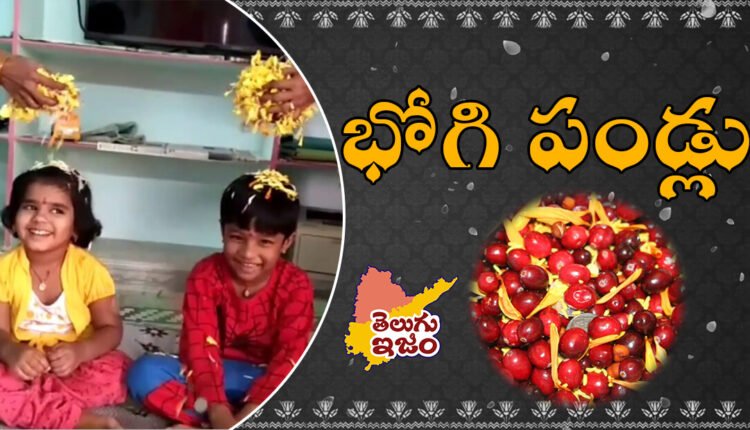Bhogi Pallu : An Important & Significant Event In Sankranti
Bhogi Pallu : A Tradition is associated with the festival of Sankranti. While this tradition has declined in recent times, it used to be a common practice in households with young children. The tradition originated from a very old age and is observed on the evening of the Bhogi festival.
During the Bhogi festival, Bhogi fruits are typically poured on children under the age of five. It is believed that offering plum fruits to young children helps remove any ill effects or diseases and contributes to their health. At the age of five, the “brahmarandhra” (the aperture on the crown of the head) and the “Rekha Ara” (a subtle energy channel) are thin. However, figs have high nutritional value and help boost immunity.
Elders believe that the fragrance of the regi fruit (plum fruit) when poured on the child’s head energizes the “brahma hole” and enhances intellectual strength.
The tradition begins with performing Harati (ritual of waving lighted lamps) to Lord Krishna, with the children sitting on a chair. First, Harati is offered to Lord Krishna, followed by applying Harati to the children. After the initial offering of Bhogipand to Lord Krishna, the children are given a little bit of the fruit three times. This process continues until everyone has had their turn. Additionally, mothers set up a parant (a traditional sieve-like plate) and give yellow saffron to neighboring women, along with serving southern Tambulas (betel leaves and nuts).
Bhogi Pallu & Preparation
When preparing Bhogipand, fruits such as plums, soaked chickpeas, marigold petals, and figs are added. The fruits eaten on Sankranti are referred to as festival fruits. Pouring Bhogipand is symbolic of plums being meant for human consumption rather than being consumed by animals, highlighting their significance in Hindu culture.
During the festival, children are also given Bhogipand along with small coins. It is believed that if a plum stands on the child’s head, they become a “Bhogi,” and if only plums stand, they become a “Yogi.” Plums are also known as “badariphalam” because it is said that Narayana (Lord Vishnu) performed intense penance in Badarikavana to please Lord Shiva. During that time, the gods showered badari fruits (plums) on Narayana’s head. As a symbol of that event, the tradition of offering Bhogipand to children is observed.
The belief behind pouring sun-colored fruits on children is to seek blessings from the sun. Bhogi fruits can be poured on the heads of girls under 12 years of age before they reach puberty.
Also Read : Bottu : A Sacred & Significant Practice In Hindu Tradition

